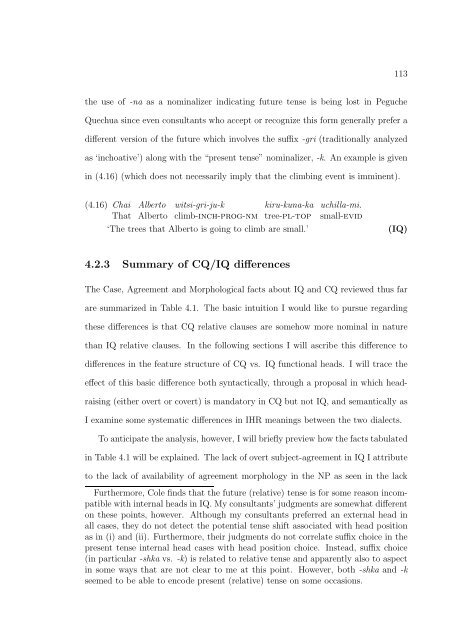the syntax and semantics of relativization and quantification
the syntax and semantics of relativization and quantification
the syntax and semantics of relativization and quantification
Create successful ePaper yourself
Turn your PDF publications into a flip-book with our unique Google optimized e-Paper software.
113<br />
<strong>the</strong> use <strong>of</strong> -na as a nominalizer indicating future tense is being lost in Peguche<br />
Quechua since even consultants who accept or recognize this form generally prefer a<br />
different version <strong>of</strong> <strong>the</strong> future which involves <strong>the</strong> suffix -gri (traditionally analyzed<br />
as ‘inchoative’) along with <strong>the</strong> “present tense” nominalizer, -k. An example is given<br />
in (4.16) (which does not necessarily imply that <strong>the</strong> climbing event is imminent).<br />
(4.16) Chai<br />
That<br />
Alberto<br />
Alberto<br />
witsi-gri-ju-k<br />
climb-inch-prog-nm<br />
kiru-kuna-ka<br />
tree-pl-top<br />
‘The trees that Alberto is going to climb are small.’<br />
uchilla-mi.<br />
small-evid<br />
(IQ)<br />
4.2.3 Summary <strong>of</strong> CQ/IQ differences<br />
The Case, Agreement <strong>and</strong> Morphological facts about IQ <strong>and</strong> CQ reviewed thus far<br />
are summarized in Table 4.1. The basic intuition I would like to pursue regarding<br />
<strong>the</strong>se differences is that CQ relative clauses are somehow more nominal in nature<br />
than IQ relative clauses. In <strong>the</strong> following sections I will ascribe this difference to<br />
differences in <strong>the</strong> feature structure <strong>of</strong> CQ vs. IQ functional heads. I will trace <strong>the</strong><br />
effect <strong>of</strong> this basic difference both syntactically, through a proposal in which headraising<br />
(ei<strong>the</strong>r overt or covert) is m<strong>and</strong>atory in CQ but not IQ, <strong>and</strong> semantically as<br />
I examine some systematic differences in IHR meanings between <strong>the</strong> two dialects.<br />
To anticipate <strong>the</strong> analysis, however, I will briefly preview how <strong>the</strong> facts tabulated<br />
in Table 4.1 will be explained. The lack <strong>of</strong> overt subject-agreement in IQ I attribute<br />
to <strong>the</strong> lack <strong>of</strong> availability <strong>of</strong> agreement morphology in <strong>the</strong> NP as seen in <strong>the</strong> lack<br />
Fur<strong>the</strong>rmore, Cole finds that <strong>the</strong> future (relative) tense is for some reason incompatible<br />
with internal heads in IQ. My consultants’ judgments are somewhat different<br />
on <strong>the</strong>se points, however. Although my consultants preferred an external head in<br />
all cases, <strong>the</strong>y do not detect <strong>the</strong> potential tense shift associated with head position<br />
as in (i) <strong>and</strong> (ii). Fur<strong>the</strong>rmore, <strong>the</strong>ir judgments do not correlate suffix choice in <strong>the</strong><br />
present tense internal head cases with head position choice. Instead, suffix choice<br />
(in particular -shka vs. -k) is related to relative tense <strong>and</strong> apparently also to aspect<br />
in some ways that are not clear to me at this point. However, both -shka <strong>and</strong> -k<br />
seemed to be able to encode present (relative) tense on some occasions.
















